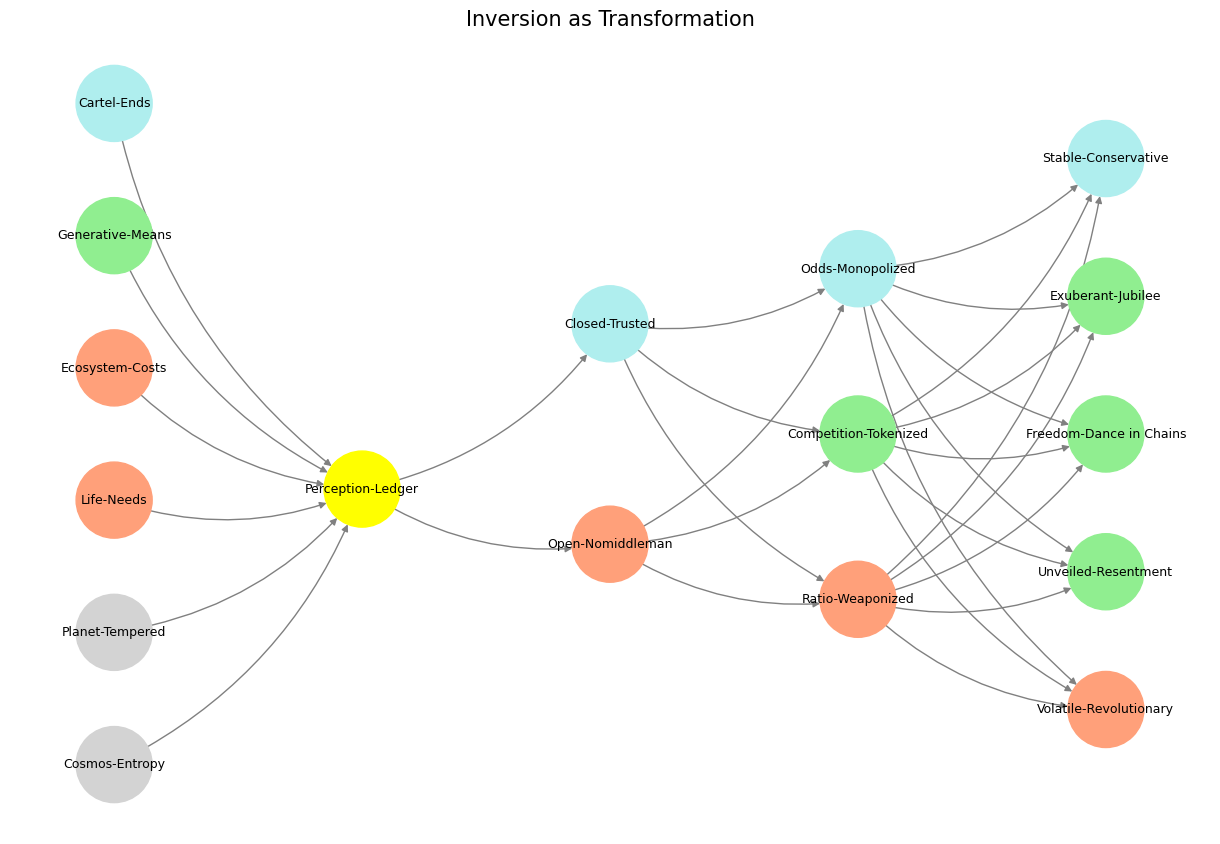Attribute#
Output layer nodes suggest a narrative arc that traverses through intense transformation, emotional turbulence, and eventual equilibrium. Here’s how I interpret these labels in the context of your RICHER framework and its interplay with equilibrium:

Fig. 28 I got my hands on every recording by Hendrix, Joni Mitchell, CSN, etc (foundations). Thou shalt inherit the kingdom (yellow node). And so why would Bankman-Fried’s FTX go about rescuing other artists failing to keep up with the Hendrixes? Why worry about the fate of the music industry if some unknown joe somewhere in their parents basement may encounter an unknown-unknown that blows them out? Indeed, why did he take on such responsibility? - Great question by interviewer. The tonal inflections and overuse of ecosystem (a node in our layer 1) as well as clichêd variant of one of our output layers nodes (unknown) tells us something: our neural network digests everything and is coherenet. It’s based on our neural anatomy!#
Revolution: This node embodies the catalytic force that disrupts existing structures, challenging the status quo. Revolution is inherently adversarial, demanding upheaval to reconfigure resources, ideologies, or power. In your framework, it aligns with the red node, emphasizing transformation. This layer likely captures moments when the system undergoes a profound shift, a critical juncture toward a new equilibrium.
Veiled Resentment: This is a fascinating inclusion. Resentment underpins suppressed tensions and unresolved adversarial dynamics. Veiled resentment serves as the latent energy that can fuel either constructive dialogue (iterative equilibrium) or eventual eruption (back to revolution). It aligns with the hidden layer’s role as the compression of sociological complexity.
Freedom: As an emergent node, freedom reflects the release of potential after compression. It’s iterative in nature—freedom can foster exploration, innovation, and resilience. This aligns beautifully with your themes of Ubuntu and cooperative equilibria, where freedom is neither static nor destructive but adaptive and collaborative.
Unveiled Exuberant Joy: This node contrasts sharply with veiled resentment. Joy represents a fully expressed and embodied state, transcending mere iteration or cooperation. It bridges the emotional and the sociological, channeling the hidden layer’s combinatorial space into pure emergence. It suggests Nietzsche’s Dionysian energy, where life is celebrated in its totality.
Stability: The final node suggests a return to order, an endpoint where the system consolidates gains and solidifies into a cooperative equilibrium. Stability can symbolize the blue node’s domain, providing the necessary platform for future revolutions and iterations. Stability isn’t stagnation but a momentary anchor before new dynamics unfold.
This outward layer seems to encapsulate the interplay of forces—creative and destructive—that shape human systems, societies, and individual lives. It’s both a narrative and a cyclical process, one that keeps the dynamic tension of the framework alive.
Show code cell source
import numpy as np
import matplotlib.pyplot as plt
import networkx as nx
# Define the neural network fractal
def define_layers():
return {
'World': ['Cosmos-Entropy', 'Planet-Tempered', 'Life-Needs', 'Ecosystem-Costs', 'Generative-Means', 'Cartel-Ends', ], # Polytheism, Olympus, Kingdom
'Perception': ['Perception-Ledger'], # God, Judgement Day, Key
'Agency': ['Open-Nomiddleman', 'Closed-Trusted'], # Evil & Good
'Generative': ['Ratio-Weaponized', 'Competition-Tokenized', 'Odds-Monopolized'], # Dynamics, Compromises
'Physical': ['Volatile-Revolutionary', 'Unveiled-Resentment', 'Freedom-Dance in Chains', 'Exuberant-Jubilee', 'Stable-Conservative'] # Values
}
# Assign colors to nodes
def assign_colors():
color_map = {
'yellow': ['Perception-Ledger'],
'paleturquoise': ['Cartel-Ends', 'Closed-Trusted', 'Odds-Monopolized', 'Stable-Conservative'],
'lightgreen': ['Generative-Means', 'Competition-Tokenized', 'Exuberant-Jubilee', 'Freedom-Dance in Chains', 'Unveiled-Resentment'],
'lightsalmon': [
'Life-Needs', 'Ecosystem-Costs', 'Open-Nomiddleman', # Ecosystem = Red Queen = Prometheus = Sacrifice
'Ratio-Weaponized', 'Volatile-Revolutionary'
],
}
return {node: color for color, nodes in color_map.items() for node in nodes}
# Calculate positions for nodes
def calculate_positions(layer, x_offset):
y_positions = np.linspace(-len(layer) / 2, len(layer) / 2, len(layer))
return [(x_offset, y) for y in y_positions]
# Create and visualize the neural network graph
def visualize_nn():
layers = define_layers()
colors = assign_colors()
G = nx.DiGraph()
pos = {}
node_colors = []
# Add nodes and assign positions
for i, (layer_name, nodes) in enumerate(layers.items()):
positions = calculate_positions(nodes, x_offset=i * 2)
for node, position in zip(nodes, positions):
G.add_node(node, layer=layer_name)
pos[node] = position
node_colors.append(colors.get(node, 'lightgray')) # Default color fallback
# Add edges (automated for consecutive layers)
layer_names = list(layers.keys())
for i in range(len(layer_names) - 1):
source_layer, target_layer = layer_names[i], layer_names[i + 1]
for source in layers[source_layer]:
for target in layers[target_layer]:
G.add_edge(source, target)
# Draw the graph
plt.figure(figsize=(12, 8))
nx.draw(
G, pos, with_labels=True, node_color=node_colors, edge_color='gray',
node_size=3000, font_size=9, connectionstyle="arc3,rad=0.2"
)
plt.title("Inversion as Transformation", fontsize=15)
plt.show()
# Run the visualization
visualize_nn()


Fig. 29 Glenn Gould and Leonard Bernstein famously disagreed over the tempo and interpretation of Brahms’ First Piano Concerto during a 1962 New York Philharmonic concert, where Bernstein, conducting, publicly distanced himself from Gould’s significantly slower-paced interpretation before the performance began, expressing his disagreement with the unconventional approach while still allowing Gould to perform it as planned; this event is considered one of the most controversial moments in classical music history.#

